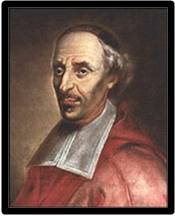MAY 6 - BLESSED FRANCOIS DE MONTMORENCY LAVAL

Blessed Francois was the first bishop of Quebec City, Canada.
He was the third son of Michelle de Péricard and Huges de Laval, a soldier. Francois was born at Montigny-sur-Avre, a small town in Normandy, France. His was an old, well respected and religious family, so Francois received a good, Catholic education.
He studied with the Jesuits at La Fleche from the age of eight and when he was quiet young felt God calling him to become a priest. Then he went to a Jesuit college in Paris to complete his preparation for the priesthood and Francois became a priest in May, 1647. He was consecrated a bishop on December 8, 1658, and arrived in New France in 1659.
Bishop Laval had a missionary spirit and accepted the new way o life of his people. Francois also bravely took on the difficult job of organizing the Church in Canada which was still mission territory. Bishop Laval asked the Jesuit missionaries to care for the spiritual needs of the native people.
He opened new parishes for the French-speaking Catholics. He started the seminary of Quebec in 1663. This was of great importance because a good seminary would train future priests to care for God’s people, the Church. He also started the Catholic school system all over Canada
Bishop Laval loved the people of his vast territory. He was a caring and prayerful bishop and built the cathedral of the Immaculate Conception. He boldly spoke to the civil authorities about the harmful affects of smuggling alcohol to the Indian tribes. Because of this he made many enemies.
In 1688, he retired and went to live as a hermit at a seminary in Quebec. He was replaced by Bishop de Saint-Vallier. Bishop Laval spent the last twenty years of his life doing works of charity to help the poor and encouraging people become more holy. He died in 1708 in Quebec, Canada and many miracles took place when people prayed at his tomb.



